#11 in the Nugget Series
Catch spring in the act!
by Patty Guertin
March 6, 2017
Last updated 10/18/23
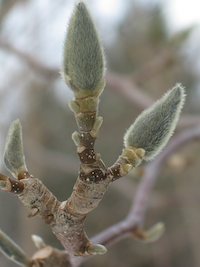
Resting buds transitioning out of dormancy - which buds are which? What are the cues? When do I start reporting?
The cues for a plant’s transition from dormancy to renewed activity can be subtle, yet can be quite visible if you are watching closely. It may take careful sleuthing—and sometimes previous experience—to detect the early stages. The tightly clasping bud scales of the dormant buds—or tightly packed leaves of naked buds—begin to shift or ever-so-slightly "swell" and may also shift color. These signals suggest that reporting on "Breaking leaf buds" and "Flowers or flower buds" is not long off.
Its spring, glorious spring, and plants may be coming out of winter dormancy and becoming active on your site. Time to go out and catch their early activity and changes - and make some observations for Nature’s Notebook!
So, armed with your species’ notes, datasheets and pencils, you locate your plant and take a closer at what is going on. And, let’s take a look at how there is overlap in the questions that are asked for the phenophase observations.
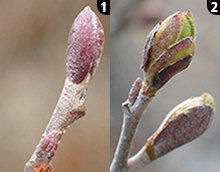
At first look, the tree and its branches are still looking quite bare. A closer look for a focus on its buds shows that buds are both still dormant with some buds that have their bud scales barely opening with a hint of green peeking out at the top of the bud.
On the species’ datasheet, under the leaves phenophases, the first question asks “Do you see…?”
“Breaking leaf buds”, with the definition for this phenophase being:
One or more breaking leaf buds are visible on the plant. A leaf bud is considered "breaking" once a green leaf tip is visible at the end of the bud, but before the first leaf from the bud has unfolded to expose the leaf base at its point of attachment to the leaf stalk (petiole) or stem.
The choices for recording this observation are: “yes”, “no”, and “?”. "Yes" - if you observe breaking buds - even if you only see a few on the branches; "no" - if you observe only dormant buds on the branches; “?” if you are unsure of the bud’s activity.
The next question under the leaves phenophases is called “Leaves”. The definition states: One or more live, unfolded leaves are visible on the plant. A leaf is considered “unfolded” once its entire length has emerged from a breaking bud, stem node or growing stem tip, so that the leaf base is visible at its point of attachment to the leaf stalk (petiole) or stem. Do not include fully dried or dead leaves.
Again, the choices for recording this observation are: “yes”, “no”, and “?”. "Yes" - if you observe any “unfolded” leaves - even if you only see a few on the branches; "no" - if you observe only dormant or breaking buds on the branches (not yet “unfolded” leaves); “?” if you are unsure of the leaf activity.
The next question under the leaves phenophases is called “Increasing leaf size”. The definition states: A majority of leaves on the plant have not yet reached their full size and are still growing larger. Do not include new leaves that continue to emerge at the ends of elongating stems throughout the growing season.
You would record “yes”—if you observe that most leaves that are on the plant are still increasing in size—even if you only see a few on the branches; "no"—if you observe only dormant or breaking buds on the branches (not yet “unfolded” leaves) or if most of the leaves are already full-sized; “?” if you are unsure of the leaf activity.
In summary, for this trip out to your site (based on the photos above) for the leaves phenophases you would record:
Breaking leaf buds - yes
Leaves - no
Increasing leaf size - no
A few days later you revisit your site and discover that your plant has more green activity on it, and growth has advanced a bit. Once again, you would take a closer look and you see buds and new leaves in several stages of growth.
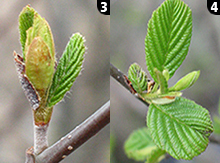
Again, there are a few dormant buds left, and some breaking buds, and you also observe some unfolded leaves (photo 3) where you can see the leaf stalk or leaf base - and some leaves that have unfolded and are increasing in size (photo 4).
In summary, for this site visit (based on these newer photos) for the leaves phenophases you would record:
Breaking leaf buds - yes
Leaves - yes
Increasing leaf size - yes
Each phenophase observation should be regarded as a separate question, not at all dependent on the other questions that you have answered. So, quite often you will answer yes to the different, yet similar, phenophase questions.
It does seem redundant to be answering seemingly similar questions, but by answering each of these observation questions separately each time you make a visit to your site over the weeks of plant activity, it allows scientists and researchers, managers and information gatherers, and you, in the years to follow, to study the records of the observations and separate out just how the plant behaves over time.
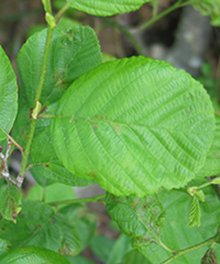
The separate questions help define the period a plant takes for all of its buds to break, its leaves to unfold, for the leaves to reach full size, and for the plant to gain its full potential as a photosynthetically active individual. These questions indirectly measure how long the plant is in various phases - its leaf, flowering and fruiting phases, and how these phases overlap with each other. From these records, one could look at how plant behavior differs across the years and how weather may influence its growth in colder, warmer, wetter, or drier years. Patterns can be discerned upon analysis of observations made in Nature’s Notebook by the participant’s records.
Over the course of a year, a species’ pattern, and their overlaps, might look like the diagram:
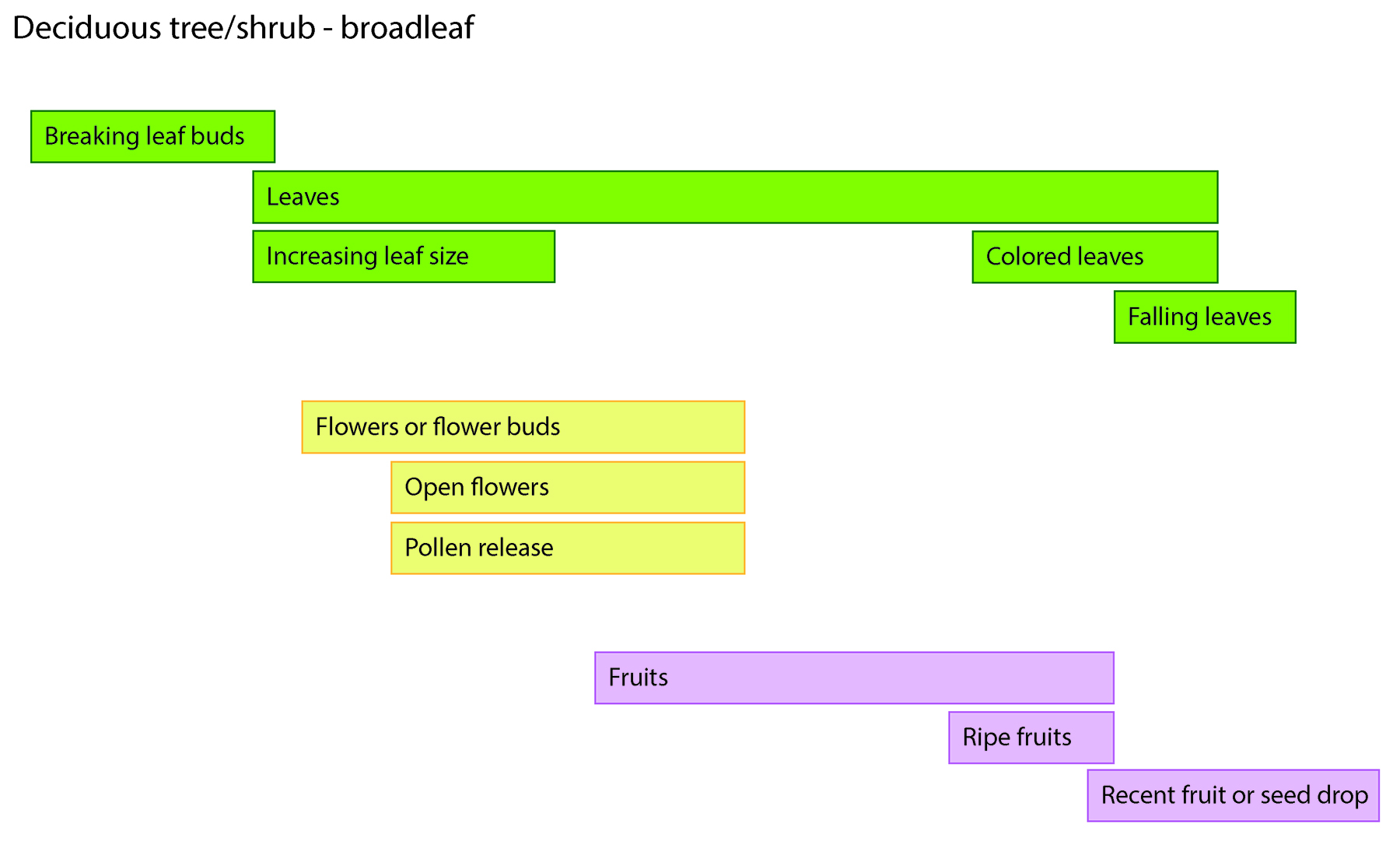
To repeat this concept of overlapping phenophase observations, let’s consider some of the flower phenophases, and let’s use a flowering shrub to make these observations.
The field sheet identifies a phenophase called “Flowers or flower buds”, with the definition stating: One or more fresh open or unopened flowers or flower buds are visible on the plant. Include flower buds or inflorescences that swelling or expanding, but do not include those that are tightly closed and not actively growing (dormant). Also do not include wilted or dried flowers.
Again, taking a really close look at your plant, you observe flower buds and flowers in many stages of flowering.
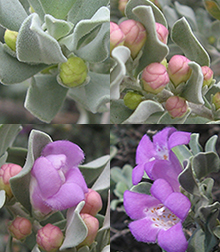
The options offered for the answers to your observations of this phenophase are “yes”, “no”, and “?”. And what you have observed at this time is that yes, you have buds (at different stages of growth), and there is a partially opened flower - but you can’t see the male stamens or the female stigmas yet, so it isn’t really considered open yet - and then there are some flowers of which you can see the male and female parts - so it is an “open" flower by definition. For this question, you would answer “yes” if any of these stages of flower existed on your plant. Yes if you only saw swelling buds, yes if you only saw partially opened flowers, yes if you only saw open flowers, or yes for any combination of these stages.
Following this phenophase question is another phenophase question about flowers called “Open flowers”. Its definition states: One or more open, fresh flowers are visible on the plant. Flowers are considered “open” when the reproductive parts (male stamens or female pistils) are visible between or within unfolded or open flower parts (petals, floral tubes or sepals). Do not include wilted or dried flowers.
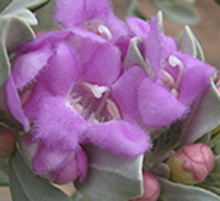
And as we have observed while looking around the plant for the first flower phenophase question, we did observe “Open flowers”, seeing the male stamens and the female stigmas so again, we will answer "yes" to this phenophase question.
In summary, for this site visit for the flowers phenophases you would record:
Flowers or flower buds - yes
Open flowers - yes
Have fun this spring with the Nature’s Notebook observations!